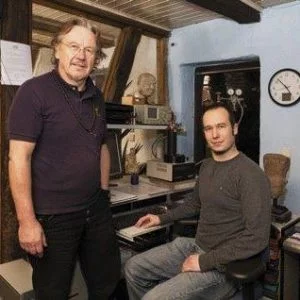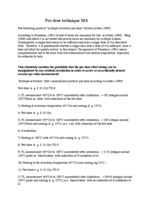The Experts

Ralf Kotalla gained his first, important experience with ceramics through activities in the art trade, gallery and antiques business. In 1979 he had first contacts with the field of forgery analysis and convinced the Rathgen-Institute, Berlin, of the idee to draw up expert reports for commercial purposes. Therupon he attended first training courses at the Rathgen-Institute, Berlin. Further courses completing his training an he had himself trained as radiation security agent. in 1979 he founded after the acquisition of the first TL-district at “Littlemoore Co.”, Oxford, the Laboratory for Forgery Detection – Ralf Kotalla.
Ralf Kotalla can now look back on 40 varied, rich experiencend years in laboratories, in which the technology of the new laboratory equipment was more sophisticated and accurate and the experience grew steadily in about 1300 reports per year. He is a member of “BVK” • Bundesverband öffentlich bestellter vereidigter Kunstsachverständiger sowie qualifizierter Kunstsachverständige e.V.
For several years, Ralf Kotalla is assisted by his son Benjamin Kotalla, who joined after his successful studies in his father’s business.
Area of competence
Reliable evaluation of the authenticity of baked clay objects requires, besides complex technical equipment, wide expert knowledge. Authenticity Analyzes of art objects sometimes differ substantially from analyzes of secured scientific findings. There are usually much larger amounts of samples. In addition, it is possible to detect environmental data of storage, which flows into the age calculation. 40 years of TL-analysis of ceramics from such differnt areas as, for example, Chinese, Antique, African or Pre-Columbien culture underlines great experience. The tests for authencity are performed according to the thermoluminecence-procedure (TL). Latest computer technology supports and completes analysis. Thus defination of age is possible with +/- 15-35% exactitude. This is more than sufficient to identify modern imitations.
The certificate
The Ralf Kotalla Laboratory establishes only top quality expert reports. These are outstanding by quickness of analysis, precision of statements and layout. In urgent cases, transportation of objects for analysis or the taking of samples on the spot, abroad or at home, are part of the institute´s extensive service. Regular visits to Paris, Brussels and Zurich round off our service.
In all cases, from the taking of samples to the complete expert´s report, Ralf and Benjamin Kotalla are your partners.
TL-systems:
- 2 x Lexsysmart Freiberg Instruments ; Daybreak Tl 1150; Tl 1100;
- Alpha and Beta Multiple Sample Irradiator Littlemore and 2 Daybreak
- Filter: Schott BG 39-BG29 KG 3 ; Daybreak Corning 7-59 / 5-60; Schott BG-39
- PMT Hamamatsu H7360-02 Lexsmart ; EMI 9235QA Daybreak
- ß-Source: Lex Sr 90 0,131 Gy/sec. 01.04.2017 Daybreak 0,068 Gy/sec 01.04 2017
- a-Source: CM-244 Curium 0,5 mCi
Working method
- Fine grain sedimentation following treatment in diluted hydrochloric acid.
- 2 Grain size fraction following repeated double sedimentation 4- 11 and 15-50 micro m
- ultrasonication in the beginning to get all the fine grains into suspension to get rid oft he
- sub-micron particles.Measurements are carried out in an ultra- pure nitrogen atmosphere of at least 5,0 N2.
Regeneration and Addition (MAR-MAAD ) method ( Second glow –Normalization ) Pre-dose :
Result provides a statement on the last time of firing.
The age specification contained in the TL expertise refers to the so-called “firing age”of the sample(s) (minerals), i.e. to the time at which they were last heated to a temperatureof over 500 degrees C and mentions the place on the object from which the sample (s)was / were taken.TL measurements to specify age can be falsified if objects have been subjected to high X and Y radiation doses or neutron bombardment.X – radiation, for example during the course of baggage controls, is no significance.( Error factor under 0,1 % )The TL-Report do not provide on the investigation of polymers (synthetic and natural resins)of all kinds.If an object has been re-modelled, the date of the sample will the last firing and not the date of re-modelling . Th and U value with ICP/MS K value with AMS/AES can be order separate .
Sampling:
Samples are taken using a drill ( TiC (titan carbide) – WC (tungsten carbide : Hardness is about 9 on Moh’s scale) 2,5 -3mm) at low speed following previous removal of the surface.. As a rule, two -three samples are taken from each test specimen, which are subjected to two-three separate TL analyses , in each case specifying the drilling position.The sample quantities are minimal (50-200 mg).If restoration work of the samples is discovered in one of the objects to be tested, the TL expertise carries the appropriate reference.Condition and restoration on the objects can be proofed by separate methods!!
Photos:
The laboratory requires one photo for the compilation of a Tl expertise.The laboratory guarantees strict confidentiality in the processing of TL-analyses and the compilation of TL expertise’s.Expertise’s are printed out without specifying the name of the commissioning party
 Pre-dose technique MAPlease click for more information about "Pre-dose technique MA".
Pre-dose technique MAPlease click for more information about "Pre-dose technique MA".
